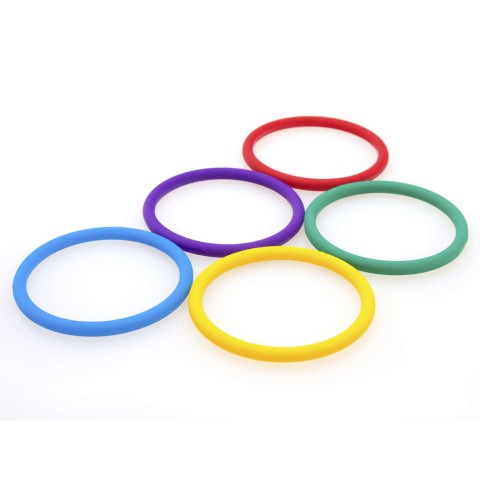
Learning a new language is a great adventure. On your journey, you’ll come across many tricky sounds, some confusing grammar, and many words that seem to behave strangely for no good reason…
But all good adventurers come prepared, and we’re here to help you prepare! That is, we’ll shine our spotlight on the ten most common Finnish mistakes, so that your journey will go that much more smoothly. In addition, knowing what Finnish mistakes to watch out for will give you an easier time making yourself understood when speaking with locals.
We’ll be looking at common pronunciation mistakes for Finnish-learners, typical mistakes in Finnish grammar, and a few other things that Finnish-learners often struggle with. Be sure to read to the end of this guide, where we’ll reveal the biggest mistake of all!
 Table of Contents
Table of Contents
- Long Vowels and Double Consonants
- Tricky Sounds
- Common Homonyms
- The Many Meanings of No niin!
- Postpositions
- The Object Trilemma: Partitive, Nominative, or Accusative?
- Vowel Harmony
- Consonant Gradation
- Repeating Things Unnecessarily
- Not Preparing for Spoken Finnish
- The Biggest Mistake!

Älä huoli, kaikki tekevät virheitä! (“Don’t worry, everybody makes mistakes!”)
1. Long Vowels and Double Consonants
Have you noticed how many Finnish words sound extremely similar to each other? Often, the only difference is a double letter, so it’s very easy to mix up similar words. However, taking time to tune your ear to the sound of long vowels and double consonants—and getting your pronunciation right—is very important. A single letter can change the meaning of a word drastically.
Consider these very similar-sounding statements:
- Tapaan Esan huomenna! (“I’m meeting Esa tomorrow!”)
- Tapan Esan huomenna! (“I’m killing Esa tomorrow!”)
Poor Esa will surely hope you meant the first one! Here are other examples of words that look and sound very similar:
- tuli / tuuli / tulli (“fire” / “wind” / “customs”)
- muta / mutta / muuttaa (“mud” / “but” / “to move”)
- tili / tiili / tilli (“account” / “brick” / “dill”)
Here’s the rule of thumb when it comes to pronunciation: Double equals longer and stronger.

Tuli, ei tuuli! (“Fire, not wind!”)
2. Tricky Sounds
While most sounds in Finnish will present no problems for English-speakers, there are a couple that can be challenging and require some practice to get right. Trust us, with enough practice and exposure, you’ll be able to avoid an embarrassing pronunciation mistake in Finnish later on down the line.
Let’s take a closer look at the Finnish ä, ö, y, and r!
Ä
Ä: pronounced like “a” in “that” and “cat”
Ää: pronounced like the “a” in “bad” and “sad”
Go ahead and say these words out loud:
- äkkiä (“quickly”)
- äiti (“mother”)
- ääni (“sound”)
- häät (“wedding”)
Ö
Ö: Pronounced like “e” in “better”
Öö: Pronounced like “ea” in “earn” or “u” in “turn”
A few words for you to practice with:
- öinen (“nightly”)
- ötökkä (“bug”)
- lööppi (“headline”)
- söötti (“cute” – colloquial)
Y
The “y” sound is one of the trickiest for Finnish-learners to master, because it isn’t found in English. The best way to get the sound just right is to listen to recordings of Finnish words with y and repeat those words until you feel confident.
For example, listen to the recording of tyttärentytär (“granddaughter”) on this vocabulary list.
Here are a few more words for you to practice with:
- yksi (“one”)
- nyt (“now”)
- kyynel (“teardrop”)
- tyyny (“pillow”)
R
If you’re struggling with the Finnish “r,” take heart—even many Finns get help from a speech therapist to correct their ärrävika (saying “r” incorrectly) while growing up!
If you’ve ever studied Spanish, you’ll have an advantage because the Finnish “r” is similar to the “r” sound in Spanish. The key to getting the clear sound is to really roll the “r.” You can literally feel your tongue vibrating when you’re doing it right!
Note that the Finnish “r” is made at the front of the mouth (the same place where you make the “d” sound!), while the English “r” is made further back in the mouth.
Here’s a selection of Finnish words to practice rolling your “r” with. Remember to make the sound longer when you see a double “r”!
- ravintola (“restaurant”)
- radio (“radio”)
- suuri (“big”)
- murre (“dialect”)
If you’re feeling especially brave, try this Finnish tongue-twister:
- Ärrän kierrän ympäri orren. (“I wrap the ‘r’ around the perch.”)
Would you like more help with your pronunciation? FinnishPod101.com has a comprehensive guide to Finnish sounds and how to master them, a Finnish alphabet page, and a relevant audio lesson.

The Finnish sound “y” is made with rounded lips.
3. Common Homonyms
Alright, so we’ve gone on quite a bit about Finnish words that are similar to each other. Now we’re going to talk about homonyms—words that sound and look the same but have different meanings. They’re very common in Finnish!
Being aware of common homonyms means that you’re less likely to trip over them, so let’s take a look at some examples, starting with the classic kuusi palaa.
The word kuusi can mean any of these things:
- “Six”
- “A fir tree”
- “Your moon” (kuu + the possessive suffix -si)
The word palaa can mean any of these things:
- “Pieces” (in the partitive case)
- “Burns”
- “Returns”
Therefore, kuusi palaa can mean a fair number of things, including “six pieces” and “the fir tree is burning”!
Here are a few more words with different meanings:
- Tuli (“fire” or “came” in third person singular)
- Keksi (“biscuit” or “invented” in third person singular)
- Kurkku (“cucumber” or “throat”)
Discover more Finnish homonyms on this list.
4. The Many Meanings of No niin!
If you’re spending time in Finland, you’ll probably hear no niin (or noni) uttered a lot. Many Finnish-learners are confused by the sheer range of meanings that this simple utterance can have. It can signal enthusiasm, disappointment, and irritation, for starters. You can’t simply decide that no niin means “well” or “now” and be done with it. The Finnish stand-up comedian Ismo Leikola went so far as to claim that no niin is the most important Finnish expression there is!
Here are a few examples of no niin in action.
- No niin, ruoka on valmista! (“Okay, the food is ready!”)
- No niin, hieno homma! (“That’s great, well done!”)
- No niin, taas mennään. (“Oh dear, here we go again.”)
- No niin, aika näyttää. (“Well, time will tell.”)
5. Postpositions
In general, you’ll find that Finnish word order is not that dissimilar from the English one. Take this basic declarative sentence:
- Mies söi omenan. (“A man ate an apple.”)
It follows the subject + verb + object order that you’re already familiar with.
However, there are still a few word order surprises for Finnish-learners. A case in point is Finnish postpositions, which express place, cause, time, consequence, or relation. While in English, you would say “behind the sofa” or “after school,” in Finnish, you’ll put the adposition after your noun, hence the term postposition. Note that the noun will usually be in the genitive case.
Look at these examples with the postposition underlined:
- Sohvan takana (“Behind the sofa”)
- Pöydän päällä (“On top of the table”)
- Maton alla (“Under the rug”)
- Laatikon sisällä (“Inside the box”)
- Koulun jälkeen (“After school”)
You can learn more Finnish postpositions on Wiktionary.
Though far less common, there are a few prepositions in Finnish as well. The most useful ones to memorize are ennen (“before”) and ilman (“without”). Note that the noun is now in the partitive case.
- Ennen joulua (“Before Christmas”)
- Ilman apua (“Without help”)
Wait! Then we have a couple of words that can be either, such as keskellä (“in the middle of”) and lähellä (“near”)! Remember that the order affects the case of the noun.
- Keskellä kaupunkia (“In the middle of the city”)
- Kaupungin keskellä (“In the middle of the city”)
Learn more vocabulary related to positions and directions on our website.

Selän takana (“Behind the back”)
6. The Object Trilemma: Partitive, Nominative, or Accusative?
One aspect of Finnish grammar that scares prospective learners (and frustrates the current ones) the most is the use of numerous noun cases. We agree, it’s a lot to wrap your head around. But on the bright side, once you’ve mastered your noun cases, you’ll be well on your way to Finnish fluency!
The best approach to learning the noun cases is to focus on a few at a time and practice them a lot (and then practice them some more). Right now, we’ll focus on the tricky trilemma of choosing whether to put the object of your sentence into the nominative, accusative, or partitive case. Getting it wrong is one of the easiest mistakes in Finnish to make, but we know that you can do this!
1. The object in the partitive case
Choose the partitive when:
- The object follows a partitive verb, such as rakastaa (“to love”), vihata (“to hate”), or odottaa (“to wait for”).
- The object is a part of a negative sentence.
- The object follows a number.
- The action is taking place now and may not be fully completed.
- The object is uncountable.
Examples:
- Minä rakastan sinua. (“I love you.”)
- En halua koiraa. (“I don’t want a dog.”)
- Sanna lukee kirjaa. (“Sanna is reading a book.”)
- Arto juo kahvia. (“Arto is drinking coffee.”)
2. The object in the nominative case
Choose the nominative when:
- The object follows a verb that’s in the passive form.
- The object follows a necessive, such as minun on pakko (“I have to”), minun täytyy (“I must”), or minun pitää (“I need”).
- The object follows a command.
Examples:
- Tänään siivotaan keittiö. (“Today, the kitchen is cleaned.”)
- Minun täytyy pedata sänky. (“I must make the bed.”)
- Ota puhelin. (“Take the phone.”)
3. The object in the accusative case
Finally, choose the accusative case when:
- The action has been fully completed.
- The intention is to fully complete the action.
Examples:
- Ostin kesämökin. (“I bought a summer cottage.”)
- Aion sulkea oven. (“I’m going to close the door.”)
No niin, you’ve probably already spotted a problem here. What if several of these rules apply to the same sentence? Well, in situations like that, the partitive trumps the nominative, and the nominative trumps the accusative. So, the hierarchy looks like this:
Partitive > Nominative > Accusative
Can you think of a mnemonic to help you remember the correct order? Things get more complicated when you add things like plurals or possessive suffixes into the mix, but that is a lesson for another day! For now, keep your eye on objects and cases whenever you’re reading Finnish sentences, and see if you can work out which rule is being followed.

Tyttö lukee kirjaa. (“A girl is reading a book.”)
7. Vowel Harmony
Compared to the difficulty of wrestling with the Finnish noun cases, figuring out vowel harmony is a walk in the park. Still, forgetting about vowel harmony is a common mistake in the Finnish language, so let’s take a closer look.
What exactly is vokaaliharmonia (“vowel harmony”), and why does it matter? In Finnish, vowels are grouped into front, back, and neutral vowels.
- Front vowels: A, O, U
- Back vowels: Y, Ä, Ö
- Neutral vowels: E, I
Normally, you can’t mix front and back vowels in the same word, while neutral vowels can mix with either front or back vowels. Knowing this will help you with your spelling, but more importantly, it will help you choose the right endings when you inflect words.
For example, talo (“house”) in the partitive case becomes taloa, but mörkö (“ghost”) inflected in the partitive case becomes mörköä. Words containing only neutral vowels generally take the same ending as words with back vowels. For example: vintti (“attic”) becomes vinttiä in the partitive case.
Note that there are some words that don’t follow the rules, including many loanwords.
- konduktööri (“conductor”)
- Olympialaiset (“Olympics”)

Vokaaliharmonia ei päde olympialaiset-sanaan.
(“Vowel harmony doesn’t apply to the word ‘Olympics’.”)
8. Consonant Gradation
Another type of error Finnish-learners make quite often has to do with astevaihtelu (“consonant gradation”). It’s something you’ll come across a lot in your Finnish studies, so it’s good to learn about it sooner rather than later!
Consonant gradation comes into play when we add an ending to a noun or a verb. There are “strong” and “weak” grades of words, and these grades determine whether the word changes or not. As you probably guessed, “strong” words don’t change while “weak” words do.
We’ll look at simple consonant gradation affecting words with the consonants K, P, and T.
Examples of words in the nominative case (the basic form), which is always strong:
- pankki (“bank”)
- kuppi (“cup”)
- katto (“roof”)
The same words are also strong in the following cases:
- Partitive: pankkia, kuppia, kattoa
- Illative: pankkiin, kuppiin, kattoon
- Essive: pankkina, kuppina, kattona
See? No changes there. However, when the same words are in the following cases, they become weak and drop a letter:
- Plural: pankit, kupit, katot
- Genitive: pankin, kupin, katon
- Inessive: pankissa, kupissa, katossa
- Elative: pankista, kupista, katosta
- Adessive: pankilla, kupilla, katolla
- Ablative: pankilta, kupilta, katolta
- Allative: pankille, kupille, katolle
- Translative: pankiksi, kupiksi, katoksi
That was so easy that you’ll no doubt want to know more about Finnish consonant gradation. Luckily, there’s a lot more to learn! You could start by reading this Wikipedia article or listening to this audio lesson.

Just doing some light reading on Finnish consonant gradation.
9. Repeating Things Unnecessarily
One mistake that many Finnish-learners make is putting a lot of effort into things like memorizing correct verb conjugation but not taking advantage of what they’ve learned! Whatever do we mean? Well, conjugating like a pro allows you to become “lazy.” That is, you can start dropping unnecessary words like minä (“I”)!
Take a look at this introduction:
- Hei, minä olen Helena! Minä asun Oulussa. (“Hi, I’m Helena! I live in Oulu.”)
Our example is grammatically correct. However, the conjugated verb already tells us that the subject of the sentence is “I.” Therefore, you can drop it and no one will miss it!
- Hei, olen Helena! Asun Oulussa.
Leaving out words that aren’t strictly necessary sounds more natural to Finnish ears. The same applies when you’re asking questions. Feel free to drop sinä (“you”) as well. For example:
- Puhutko sinä suomea? (“Do you speak Finnish?”)
- Puhutko suomea?
Listen to this audio lesson, where we chat more about this common mistake.
10. Not Preparing for Spoken Finnish
For many Finnish-learners, their first time talking to a Finn in real life comes as a shock. Why? Spoken Finnish can sound very different from standard Finnish!
In general, spoken Finnish is simply more economical than standard Finnish.
Here are some common features of spoken Finnish:
- Syllables are dropped.
- e.g. mutta (“but”) becomes mut.
- Words are ‘squished’ together.
- e.g. Tuutsä? (“Are you coming?”) instead of Tuletko sinä?
- The word se (“it”) replaces hän (“he” / “she”).
- The verb is in the passive form in the first person plural.
- e.g. Me ollaan koulussa. (“We are in school.”) instead of Me olemme koulussa.
- The possessive suffix is dropped.
- e.g. Minun koira (“My dog”) instead of Minun koirani.
Learn more about colloquial Finnish on Wikipedia.

Wait, are we speaking Finnish?
11. The Biggest Mistake!
No niin, we’ve finally made it to the big reveal! So, what is the biggest mistake a Finnish-learner could make? Being afraid of making mistakes! That’s right; mistakes are a part of your learning journey, so embrace them.
We certainly don’t expect you to never make any of the mistakes mentioned in this article. What we do hope, though, is that you’ve become more aware of the common pitfalls, so that you’ll notice more easily when you might have stumbled. In order to learn from our mistakes, we need to be able to notice them first!
FinnishPod101 is full of free resources to help you with your Finnish studies, so remember to make full use of them! For example, a brilliant way to perfect your pronunciation of tricky Finnish sounds is to listen to the audio recordings that accompany our vocabulary lists and repeat each word out loud!
And if you’d like an experienced teacher to help you wrap your head around consonant gradation or any other grammar rules, our Premium PLUS one-on-one coaching is perfect for you.
However you prefer to learn, we’re cheering you on!
Before you go, let us know in the comments how many of these mistakes you’ve made before. We look forward to hearing from you!










